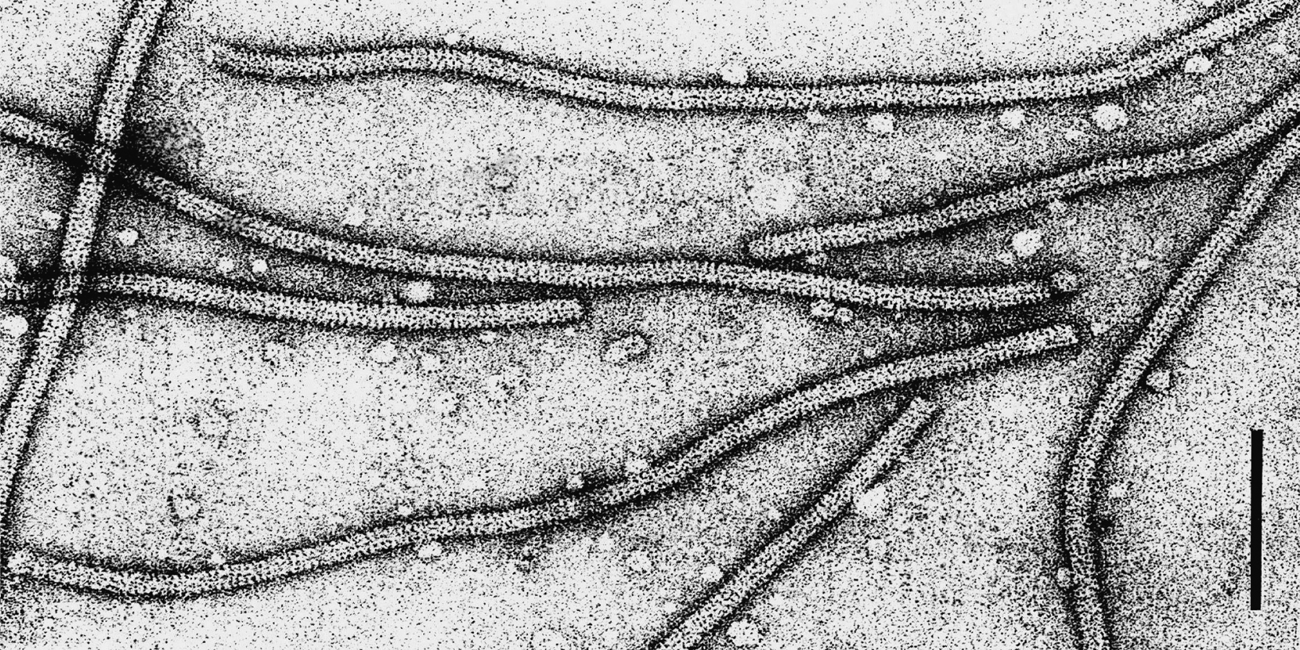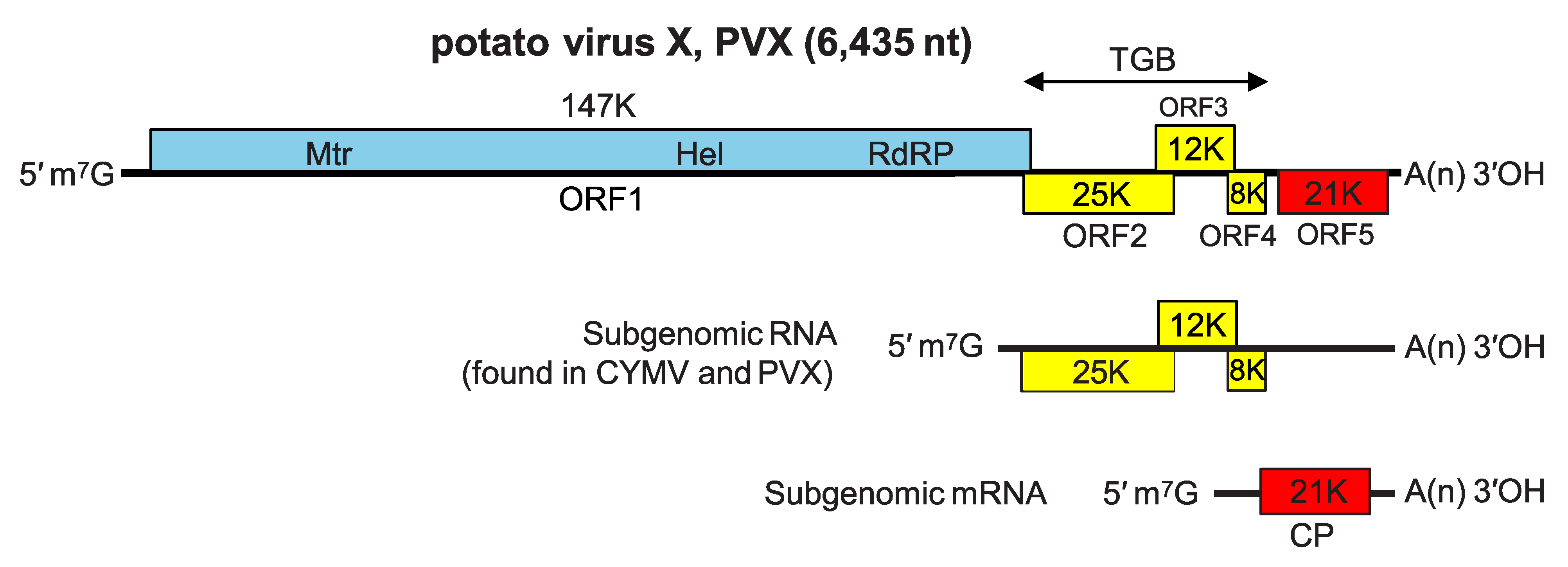Family: Alphaflexiviridae
Genus: Potexvirus
Distinguishing features
Potexviruses have relatively short virions (<700 nm) and their genomes have only five ORFs. Potexviruses infect herbaceous hosts and have no known vectors.
Virion
Morphology
Virions are flexuous filaments, 470–580 nm in length and 13 nm in diameter, with helical symmetry and a pitch of 3.3–3.7 nm (Figure 1. Potexvirus). A central axial canal, about 3 nm in diameter can sometimes be discerned. The number of protein subunits per turn of the primary helix is slightly less than 9.0. The RNA backbone is at a radial position of 3.3 nm (Atabekov et al., 2007).
 |
|
Figure 1. Potexvirus. Negative-contrast electron micrograph of particles of an isolate of potato virus X. The bar represents 100 nm (Courtesy of D.-E. Lesemann). |
Physicochemical and physical properties
The potexvirus virion Mr is about. 3.5×106; S20,w is 115–130S; buoyant density in CsCl is 1.31 g cm−3.
Nucleic acid
Virions of potexviruses contain a single linear molecule of positive-sense RNA of 5.9–7.0 kb, comprising approximately 6% by weight of the virion. The RNA is capped at the 5′ -terminus with m7G and has a polyadenylated tract at the 3′-terminus (Huisman et al., 1988) (Figure 2. Potexvirus).
Proteins
The only structural protein is the 21–27 kDa capsid protein (CP).
Carbohydrates
The capsid protein of some strains of the species Potato virus X are reported to be glycosylated (Baratova et al., 2004).
Genome organization and replication
The genomic RNA of potexviruses, as exemplified by potato virus X (PVX), typically has five ORFs (Figure 2. Potexvirus). ORF1, at the 5′-terminus, encodes the replication-associated protein (Rep) and ORF5, located at the 3′-terminus, is the CP gene. Between ORF1 and ORF5 is the triple gene block (TGB) of three overlapping ORFs, the products of which (25, 12 and 8 kDa) are involved in cell-to-cell movement. The 25 kDa protein contains an NTPase-helicase domain, but is not involved in RNA replication. It has been shown to have RNA silencing suppressor activity which is necessary for virus movement. The 12 and 8 kDa proteins contain large blocks of uncharged amino acids and are associated with membrane vesicles derived from the endoplasmic reticulum. The third TGB protein of Alternanthera mosaic virus (AltMV) (but not that of PVX) is targeted to the chloroplast and is required for movement from the epidermis to the mesophyll layer. The CP is also involved in cell-to-cell movement. ORFs 2 to 5 are expressed via the production (and subsequent translation) of subgenomic RNAs (sgRNAs). Two or three 3′-co-terminal sgRNAs can be isolated from plants infected with potexviruses (ca. 2.1, 1.2 and 1.0 kb); the double-stranded counterparts of these sgRNAs have also been detected. The medium-sized sgRNA (1.2 kb) is probably functionally bicistronic, its translation yielding the 12 and 8 kDa proteins.
Virions of PVX contain only genomic RNA, but some other potexviruses also encapsidate the sgRNA for the CP. Genomic RNA is translated as a functionally monocistronic message; only the 5′-proximal Rep gene is translated directly by ribosomes, producing the Rep protein (150–181 kDa). The 5′-UTR leader sequence of PVX RNA consists of 83 nt (excluding the cap-structure) and enhances translation.
 |
|
Figure 2. Potexvirus. Potato virus X genome organization and expression. Mtr, methyltransferase; Hel, helicase; RdRP, RNA-directed RNA polymerase; TGB, triple gene block; CP, capsid protein; |
Biology
Host range
Some potexviruses are moderately pathogenic, causing mosaic or ringspot symptoms in a wide range of mono- and dicotyledonous plant species, but others cause little damage to infected plants. The host range of individual members is usually limited, although AltMV and Plantago asiatica mosaic virus (PlAMV) infect a number of taxonomically diverse crops.
Transmission
Potexviruses are transmitted in nature by mechanical contact. Potato aucuba mosaic virus (PAMV) can be transmitted by aphids when assisted by a potyvirus that provides a helper protein.
Geographical distribution
As a group, potexviruses occur world-wide. The distribution of some species is very wide but others are apparently more geographically restricted.
Cytopathic effects
The cytoplasm of infected cells contains fibrous, banded or irregular aggregates of virus particles, and often membrane accumulation. There is no cytopathology specific to potexviruses, although some viruses induce unique structures such as the beaded sheets found in cells infected by PVX.
Antigenicity
Virions are highly immunogenic; members of some species are antigenically related, but others are serologically distinct.
Derivation of names
Potex: from Potato virus X, the type species of the genus.
Species demarcation criteria
Species are demarcated by:
- Host range: the natural host range is usually particular to different species.
- Members of distinct species fail to cross-protect in infected plants.
- Serology: members of different species (and strains of some members) are readily distinguishable in differential reactions with monoclonal antibodies.
- Sequence: isolates of different species have less than 72% nt identity (or 80% aa identity) between their CP or Rep genes.
Related, unclassified viruses
|
Virus name |
Accession number |
Virus abbreviation |
|
Caladium virus X |
||
|
Cnidium virus X |
||
|
Paris polyphylla virus X |
||
|
potexvirus 1 LSD-2014 |
||
|
potexvirus Opuntia |
||
|
potexvirus ST4 |
||
|
potexvirus ST5 |
||
|
yam potexvirus 1 |
||
|
yam potexvirus 2 |
Virus names and virus abbreviations are not official ICTV designations.

